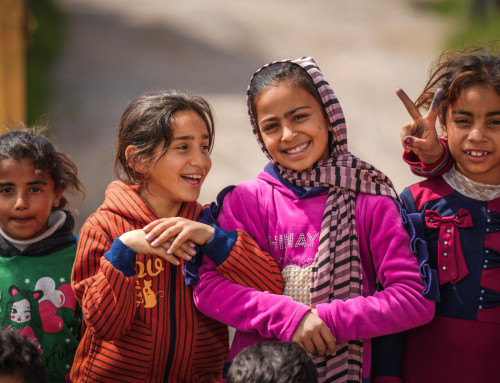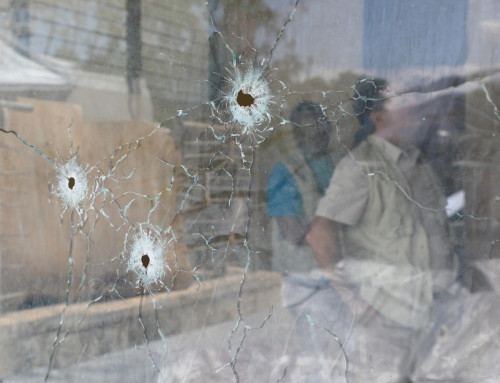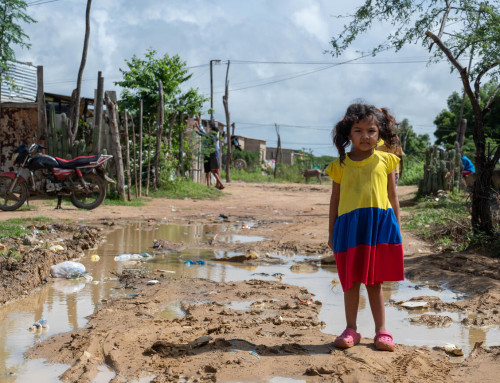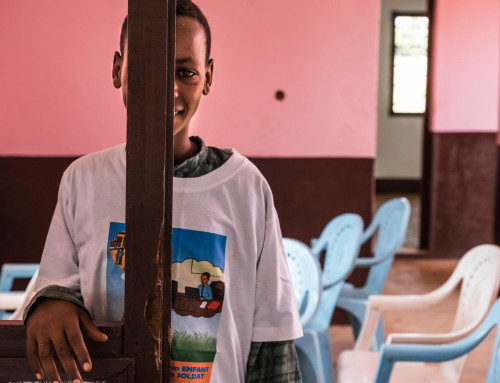14-Sep-99
HR/4432
NEW YORK, 9 September (Office of the Special Representative of the Secretary General for Children and Armed Conflict) — At the conclusion of a six-day mission to Sierra Leone and Guinea (30 August-4 September), to assess the conditions of children in the aftermath of the war and following the signing of on 7 July 1999 the Lom Peace Accord, Olara A. Otunnu, Special Representative of the Secretary-General for Children and Armed Conflict, has proposed an Agenda for Action for the Children of Sierra Leone . He also called on Sierra Leonean political leaders to take concrete and bold measures to implement the Lom Peace Accord.
Mr. Otunnu was deeply shocked by the horrendous abuse and atrocities committed against children. He stated: The children of Sierra Leone have suffered beyond belief in this war: many children have been deliberately maimed, with their limbs brutally cut off; in the month of January 1999 alone, over 4,000 children were abducted during the Revolutionary United Front (RUF)/Armed Forcers Revolutionary Council (AFRC) incursion into Freetown; 60 percent of abducted children were girls, the vast majority of whom have been sexually abused; more than 10,000 children have been serving as child soldiers in various fighting groups; over 60 percent of the 3 million Sierra Leoneans who have been displaced by war within and outside their country are children; and many children are suffering from serious psychological trauma.
During his visit to Sierra Leone, Mr. Otunnu met with President Ahmed Tejan Kabbah and several senior government officials; the leadership of the RUF, Civil Defence Forces (Kamajors) and Economic Community of West African States’ Monitoring Observer Group (ECOMOG); representatives of United Nations agencies and Non-Governmental Organisations (NGOs), and a cross-section of civil society. He visited war-affected populations in the vicinity of Freetown and in the region of Bo. In Guinea, he met with the Prime Minister, Lamine Sidimen and visited the Massakoundou refugee camp in Kissidougou. Throughout his visit, Mr. Otunnu was accompanied by the Special Representative of the Secretary-General (SRSG) for Sierra Leone, Francis Okelo and representatives of United Nations Children’s Fund (UNICEF) and United Nations High Commissioner for Refugees (UNHCR).
The Special Representative, who serves as international advocate for children affected by armed conflict by promoting their rights, protection and welfare, stated: Apart from the imperative of re-establishing credible security and peace, the crisis of the children is the most important challenge facing Sierra Leonean society today.
In view of the situation he witnessed on the ground in Sierra Leone and the initiatives launched during his previous visit (May 1998), the Special Representative has put forward an Agenda for Action for the Children of Sierra Leone. The 15-point Agenda sets out the measures necessary to ensure the rehabilitation and welfare of the children of Sierra Leone in the aftermath of the war, as follows:
1. National Commission for Children of Sierra Leone:The Special Representative has proposed the establishment of a national commission for children to ensure that the rights and welfare of children will be a central concern in the aftermath of the war in Sierra Leone and would be reflected in national priority-setting, policy-making and resource- allocation. This proposal has been welcomed by the Government as well as civil society leaders and organizations.
2. Child protection and the United Nations Observer Mission in Sierra Leone (UNOMSIL) mandate:As a general policy, the Special Representative has proposed that child protection and welfare should be an explicit priority in the mandate of every United Nations peace operation, and that a senior child protection advocate should always be attached to such operations to ensure the implementation of this component of the mandate. Those two new elements were recently incorporated into the mandate of the expanded UNOMSIL.
3. Rehabilitation of amputees:A whole new community of persons has suddenly emerged in Sierra Leone persons without limbs, a result of a diabolical practice of brutally cutting off the hands and legs of victims. This is a completely new phenomenon, one to which the community has no ready response. A special program is needed for these victims to provide trauma counselling, therapy, and technical and material support.
4. Sexually abused children:The extensive and systematic sexualabuse visited upon young girls is one of the most painful andtraumatic legacies of the war in Sierra Leone. The victims trauma is compounded by social stigma and reticence to address theissue. A special program is needed to address the special needsof this group of victims, including a campaign of sensitization oflocal communities and trauma counselling.
Access to and release of abducted children:A large number ofchildren have been abducted and remain behind rebel lines; gainingaccess to them and obtaining their release is a most pressingconcern. Mr. Otunnu demanded that the RUF leadership arrange andfacilitate necessary security arrangements for a humanitarian team tovisit the zones under their control, as a first step to the earlyrelease of the children. The RUF has agreed to this and discussionsare under way to send a team led by UNOMSIL and UNICEF.
Demobilization of child combatants:When the Special Representativevisited Sierra Leone in May 1998, a Joint Task Force for thedemobilization of child combatants was constituted, comprised ofUNOMSIL, UNICEF, ECOMOG, Civil Defence Forces (CDF) and RUFrepresentatives. With the ending of the war, there is an urgent needfor that group to take charge of an effective process of disarming,
demobilizing and reintegrating ex-child combatants; their work feedsdirectly into the overall plan and activities of the NationalCommission for Disarmament, Demobilization and Reintegration (DDR).
Recruitment and use of children:During his visit to Sierra Leone inMay 1998, the Government and CDF committed themselves not to recruitchildren under the age of 18; they have reiterated this commitmentever since, most recently in the Lom Accord and the Human RightsManifesto. The same commitment has now been made to the SpecialRepresentative by the RUF leadership. The Special Representativecalls on all the parties to observe this commitment in practice.
8. Displaced children:More than 3 million persons have been displaced by the war in Sierra Leone- over 60 per cent of whom are children. The 2. 5 million persons displaced within the country live in difficult conditions, with over-crowded and improvised shelters and inadequate relief provisions. More resources are needed to increase the capacity of relief agencies and NGOs to respond to their needs. Over half a million Sierra Leoneans have fled as refugees to neighbouring countries, mostly to Guinea, a country that has assumed a very heavy burden on behalf of the international community. The donor community needs to provide more resources to Guinea as a host country and to UNHCR to better enable them to shoulder this responsibility.
9. Rehabilitation of basic educational and medical services: Basic social facilities and services were largely destroyed during the years of war. The rehabilitation of services that benefit children, especially educational and medical facilities, particularly in rural areas, should constitute a clear priority in the post-conflict recovery programme.
Reinforcing traditional norms:The conduct of the war, particularlythe horrific atrocities, has radically undermined traditional valuesystems in Sierra Leonean societies, values that traditionally haveprovided for the protection of civilian populations, especiallychildren and women. All support must be extended to elders, localchiefs, teachers, local NGOs and religious institutions to reclaimand reinforce such traditional norms and values. This community-based process should then be integrated with and reinforced bycontemporary norms that have been developed at the internationallevel.
Neighbourhood Initiative:In many internal conflicts, thevictimization of children is often aggravated by cross-borderactivities. Mr. Otunnu has proposed the development of concrete neighbourhood initiatives within affected sub-regions, to protectchildren from cross-border threats. In the neighbourhood comprisingSierra Leone, Liberia and Guinea, such issues include: small armsflows, refugee movements, cross-border recruitment of child soldiers,family tracing and reunification. An inter-agency mission would soonvisit the sub-region to assess and propose concrete initiatives forthis purpose.
Voice of Children project for Sierra Leone:The SpecialRepresentative has been struck by the hunger for information,recreation and entertainment among children in situations of conflictand its aftermath. He has therefore proposed the development ofradio stations and programmes devoted chiefly to the needs and interests of children: to give them a voice, offer educational and entertainment programmes, and promote reconciliation. A Voice of Children project should be developed for the children of Sierra Leone.
13. Parliamentary Caucus for Children: This Caucus was constituted during the visit of the Special Representative to Sierra Leone in May 1998. It has become an effective advocacy group on behalf of children in and outside Parliament. The Caucus needs support to strengthen and expand its activities.
14. Providing training for the new national army:The Government and the Chief of Defence Staff, Brig-Gen Maxwell Khobe, have reiterated the commitment they made last year to receive assistance to be provided by United Nations agencies and relevant NGOs for training on humanitarian and human rights standards. This effort will be led by UNOMSIL and UNICEF.
15. Special Fund for War Victims: Under the Lom Accord, the parties committed themselves to set up a special fund for war victims. Mr. Otunnu has called for the early establishment of this fund, and urged that special priority be given to the needs of amputees, sexually abused children and women, and gravely traumatized children.
In conclusion, Mr. Otunnu stated: On behalf of the children of Sierra Leone, I should like to make the following appeals. I appeal to the political leaders to demonstrate their commitment to peace by taking bold and concrete measures to implement the Lom Peace Accord. In this connection, the early return to Sierra Leone of Corporal Foday Sankoh (leader of RUF) and Major Johnny Paul Koromah (leader of AFRC) and the launching of the programme for disarming combatants, are urgent and crucial for building confidence in the peace process. I urge the leadership of RUF and AFRC to level with the children of Sierra Leone and acknowledge fully their role in the horrific atrocities committed during the war, most of them directed against children and women. I also address a particular appeal to the international community not to let down the children of Sierra Leone by again adopting a wait-and-see attitude. The Lom Accord is a fragile peace that requires a lot of local and international support for its implementation and consolidation.
Statistical overview of situation of children affected by war in Sierra Leone
Access:Some 2. 6 million people are in the rebel-controlled areas and remain inaccessible due to security concerns.
Displaced children:
An estimated 2,500,000 people are internally displaced within SierraLeone, out of which over 60 per cent (in some areas 70-80 per cent)are children. Over 500,000 Sierra Leoneans are refugees in neighbouring countries,mostly in Guinea. A significant number of those who fled from thewar did not register as refugees.
Abducted and missing children:Although there are no accurate figures, a large number of children were abducted during the war, throughout the country. In Freetown alone, following the rebel incursion of January 1999, 4,162 children were registered missing, out of which 972 have been reunited with their families.
Amputees:There is no credible figure on the number of people whose limbs have been cut off. However, in one camp alone in Freetown (the Murray Town Amputees Camp), there are 257 amputees.
Sexual abuse:It is estimated that around 60 per cent of children kidnapped during the January 1999 incursion were girls; 9 out of 10 abducted girls are believed to have been sexually abused.
Street Children:There are more than 3,000 street children, mostly in Freetown.
Child risk measure :Sierra Leone is considered the second most dangerous country (after Angola) in which to be a child, according to a UNICEF survey. The eight-year war significantly contributed to this state of affairs.
Child soldiers:More than 10,000 young persons under the age of 18 are estimated to have been fighting within the ranks of the RUF, CDF and the Sierra Leone Army.
The Disarmament Demobilization and Reintegration (DDR) Programme: According to the National Commission on DDR, this programme is scheduled to begin officially on 28 September 1999. Twenty-seven Reception Centres (locations for collecting arms) and 10 Demobilization Centres (where disarmed combatants stay for 3-6 months) have been designated. Four of the Demobilization Centres are expected to be operational by 28 September.
A total of 1,409 soldiers were demobilized in July 1999 as part of an earlier (pre-Lom ) programme. A further 600 are awaiting demobilization in transition camp(s). About 200 children have been demobilized since the period after the January 1999 incursion.
UNOMSIL:The expanded UNOMSIL will have 210 military observers; 66 have been deployed to date.





